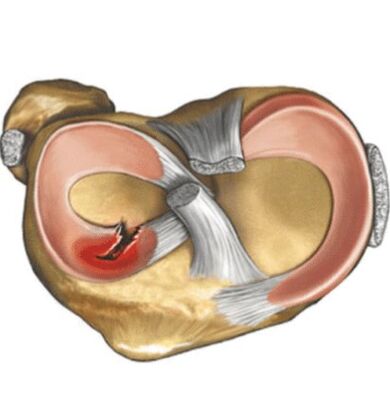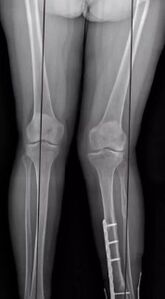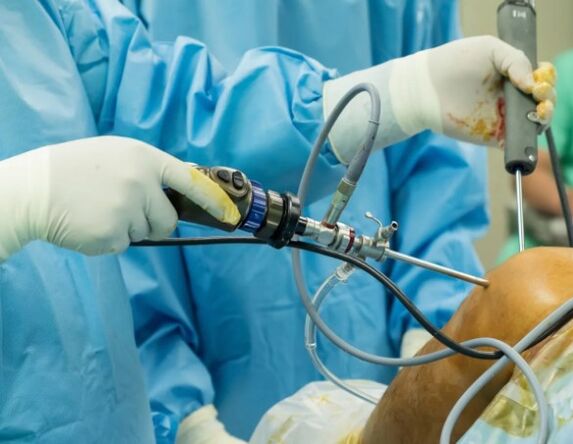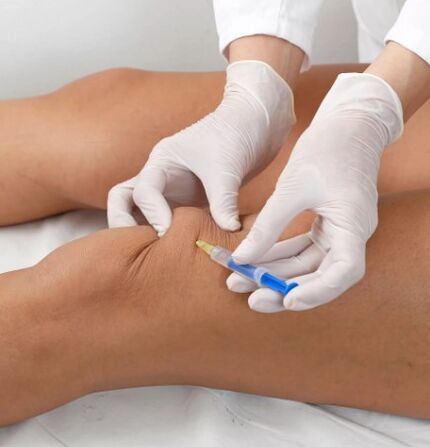The joints of the human body resist the daily load, therefore they become susceptible to various types of destructive factors. Among the diseases of the joints, arthrosis is often found and affects both large and small joints. The arthrosis of the knee joint is a degenerative dystrophic damage to the knee joint, in which its motor activity is disturbed. In the absence of adequate treatment, the disease can lead to disability.

Since the disease causes characteristics in the joints, it is called the deforming arthrosis of the knee joint, which rightly describes the typical feature of the pathology. The disease is chronic and is more often diagnosed in women, with excess weight and venous pathologies of the lower limbs, but there may be other causes. Because of age -related changes, people also arise in the elderly.
Young arthrosis can be caused by injuries. As a result of degenerative distance changes, the cartilage softens, delays and is covered by cracks of various depths. Subsequently, he ceases to perform his function.
Reasons
Various causes lead to the appearance of the deformation of the arthrosis of the knee joint. A traumatic factor is a common cause of occurrence. Post -traumatic arthrosis can develop due to the reception of dislocation or fracture in the specified area, as well as injuries to the meniscus. Generally, the gonartrosis of the knee joint appears in young people who are actively involved in sport or in those people whose work is associated with greater mobility, lifting and weight transfer.
Few people know that this damage can be a consequence of the treatment, when the injury itself is already treated, but during long -term immobilization of the limbs there were circulatory disorders in this area. For this reason, Gonartrosis has appeared.
The increase in physical effort on the knee is one of the main factors in the appearance of the disease. Very often it affects athletes who have constant active loads on the knee. At a young age, arthrosis may not appear, they usually begin quick changes after the cessation of physical activity.
There is also the risk of illness in those people who, even in adulthood, do not reduce the load on the joints. In these athletes, the risk of fractures and dislocations increases, microtrauma appear. Therefore, after forty years, doctors recommend that athletes reduce loads, they pass to coaching work. Running and squats are better excluded, since they are these types of activities that most of the knee load the knee. Very often, a limb occurs and gonartrosis occurs on the left or gonartrosis on the right.
The removal of the meniscus becomes an essential factor for the development of arthrosis of the knee joint. If for some reason the menisci have been removed, this in 90 percent of cases leads to the appearance of osteoarthritis, the so -called oven knee occurs, during which joints experience more friction than usual.

This is the case of meniscus arthroscopy - a tear - which can become a trigger for the arthrosis of the knee joint
The problem of excess weight is also relevant for people with arthrosis. Excess body weight creates unnecessary pressure on the joints. As a result, the cartilage itself is damaged, but the meniscus. And with a combination of acute oversteen arthrosis threatens the varicose veins of the lower ends.
The weak bonding apparatus in some patients is an innate feature and sometimes the ligaments are influenced by other diseases. In one way or another, weak ligaments cause greater mobility in the articulation, which is why joint surfaces are significantly abrasion. The consequences of weak ligaments can be felt for a long time until patients experience the symptoms of true arthrosis.
Joint pathologies also lead to the development of the disease. Very often, arthrosis becomes the culprit of the occurrence of arthrosis - inflammation of the joint joints. With arthritis, typical signs are observed: a deterioration of the composition of the synovial fluid, pathological changes in the cartilage, swelling, redness of soft tissues. Even after arthrosis, chronic processes lead to the appearance of arthrosis.
Violations of metabolic processes often lead to pathologies of the musculoskeletal system. The bones and joints do not receive nutrients and minerals, therefore necessary for resistance to tissues. With their lack of bone surfaces and cartilage they are subject to destructive processes, therefore, even with a slight load, primary arthrosis appears.
Symptoms
The arthrosis of the knee joint manifests itself from a complex of characteristics that are difficult not to notice. There are no signs only in the first degree of development of the pathology, but the second and third degree provide clear symptoms of arthrosis of the knee joint:
- Pain is one of the key signs, which does not manifest itself from a rhinestone. Interestingly, with the development of osteoarthritis, the pain cannot be felt even for several months or years until the disease is aggravated. Generally, the first signs of pain are discomfort in physical effort, walking or running, but is manifested even when a meniscus is pinched. In the second degree of arthrosis, the pain in the joint is felt stronger and, with the third degree of development, the painful sensations also appear at rest. The attacks are aggravated even after short walks without a strong load on the joint, so patients try to save their knees;
- Deformations: manifestations become increasingly pronounced in the third phase of the development of osteoarthritis. The knee will maintain its usual shape, but it seems slightly swollen, swollen. When the arthritis is united, the knee becomes red, it will become warm and painfully touch;
- The crystal with arthrosis appears in the second and third degree of development of the disease. The crunchy sounds differ from healthy clicks, which can sometimes be listened to when extend and bend their knees. With arthrosis, the symptoms are characterized by a dry and rude sound, which occurs abruptly and is accompanied by pain;
- Sinovite is the accumulation of a certain amount of liquid in the joint cavity. It is also contained there. But the accumulation of an excess quantity leads to the development of a cyst: the baker's cyst, which can be determined in the exposed position of the leg, is more evident;
- Limited mobility in the knee is a typical sign of pathology, since patients seek before protecting themselves from pain consciously and in an advanced phase of arthrosis, they cannot at all bend the limb. In the third degree of development, the deformation of osteoarthritis of the knee joint (Doa) even leads to the loss of movements. Patients adapt to moving on folded legs, using support products.

The degree of development
The arthrosis of the knee joint takes place in its development of three degrees.
With osteoarthritis of the 1st degree, painful pain and occurs only with an active physical effort on the knee joint. Already in the first measure, the liquid in the cavity can accumulate, which in the second and third is already a cyst. With progression, pain occurs in the movement process, but passes quickly. Externally, the deformation of the knee joint is invisible, therefore the diagnosis of arthrosis of the knee joint can be difficult.
The pain of osteoarthritis also appears when the external signs of the disease are not evident

With a second degree disease, damage to cartilage tissue is more significant. If you take a radius X, the bone growth stage is already evident. With any movement, the sudden acute pain appears in the knee, but, returning to an convenient position, the knee no longer hurts. In the second phase of Doa, you can hear a typical crisis of arthrosis. When proceeding, the problems with the extension and flexion of the knee are aggravated. The deformation becomes evident in appearance.
The osteoarthritis of the third degree knee joint is characterized by a significant thinning of the cartilage. Gradually, the cartilage is so much immersed that the bone is exposed in some areas. The X -ray image shows a significant amount of osteophytes: bone growths, salts that have appeared in the joint cavity. Externally, the changes are clearly visible and the patient deals with constant pain. It is easy to make a diagnosis: there is enough visual examination and a retigenous check is performed.
With the progression of this degree, arthrosis can lead to a complete loss of functionality. In any degree of development of the pathology, the arthrosis of the knee joint can join.
Treatment
Conservative
A group of more active drugs against arthrosis are anti -inflammatory non -pound -inflammatory drugs. These are mainly inhibitors of the cycloossigenasi-2, they can perfectly alleviate inflammation, inflate and contribute to the rapid possible recovery. These drugs have significant restrictions, therefore they cannot be used without the doctor's recommendation. For example, they are able to aggravate an ulcer of the stomach, heart disease and pathologies of the urinary organs. During pregnancy, anti -non -pounded anti -inflammatory drugs are prohibited.
The second group of funds are the chondroprotectors who improve the characteristics of the cartilage. They are used for arthrosis to restore the correct cartilage structure, because in the resolution process it loses very important components: chondroitin and glucosamine. Therefore, almost all chondroprotectors have both these substances, but some drugs are a component. With the help of these drugs, you can help the patient in the first and second stage of the development of the disease, but not in the third, when irreversible changes have occurred.

During conservative therapy, the doctor will provide recommendations for nutrition. If a patient or patient has overweight, it is necessary to adhere to a diet to normalize weight. How to strengthen the stable weight - the doctor will also say. In addition, it is not advisable to eat a lot of salt, but it is better to fill the diet with calcium, vitamins and minerals. Jelly, jelly, will be useful.
Operating
The most common type of surgery for arthrosis is arthroscopy, but other interventions are performed. The treatment of arthrosis of the knee joint is generally carried out in the second and third degree, when conservative therapy no longer helps.
If necessary, a minimally invasive intervention, for example, when a liquid accumulates in the knee joint, it is possible to do with a drilling. In the cavity of the knee joint, a drilling is carried out and the excess fluid is pumped. This method can be diagnosed with the disease, therefore it is applied simultaneously for the treatment. The liquid is taken in the initial phase in a minimum amount, but this already improves the well -being of patients significantly. So, after the study of biomaterial, another part is removed and the corticosteroids are introduced into the joint cavity.
Endoprothetics is sometimes the only way out for patients with third grade arthrosis
Artroscopy is more common. Through a small incision, several tools are introduced in the skin, which allow you to conduct a joint examination and the necessary manipulations. With the help of arthroscopy, it is possible to remove fabric particles that are separated from the cartilage, but there is always the risk that secondary gonartrosis appears.
With serious damage, it is necessary to perform a periosemic osteotomy. This is a greater effect on the joint, due to which it is slightly powered and installed on the right corner. After the operation, rehabilitation is longer, but the effect lasts longer.

The significant destruction of the joint elements leads to the complete immobilization of the limb. The joint does not satisfy its function, which means that it must be replaced and it is necessary to perform the operation. The endoprothetic of the knee joint is an expensive operation, but allows you to return the movement to the patient in the limb. Various knee prostheses are installed: plastic, ceramic or metal. These are durable constructions that allow you to forget the problem for several decades.
Physiotherapy
Physiotherapy methods can only be used when the acute period has passed and the patient is recovering.
Among the techniques are actively used:
- Ozonotherapy is the effect on the affected articulation of the ozone and the substance can be introduced into the injection or applied as an external treatment. This type of assistance to patients is very effective, therefore it is often used in the treatment of various pathologies, including arthrosis. The treatment allows you to activate blood circulation in the problematic area, to obtain an anti -inflammatory and analgesic effect. At the same time, the treatment with glucocorticoids is carried out;
- Kinesiotherapy - The treatment is carried out using a special series of exercises. The load is formed taking into account the individual data and when performing exercises, special simulators are used that strengthen the joints. The difference between kinesiotherapy and physiotherapy exercises actually active not only on knee osteoarthritis, but also on the entire body as a whole.
They use not only ozonotherapy and kinesiotherapy, but also physiotherapy exercises. Good results are given with copyright methods to eliminate the arthrosis of the knee - exercises in Bubnevsky, Evdokimenko, Dikul. During the exercises and after them, we must wear a special knee - a orhosis, to strengthen the joint of the right or left knee.



















